World’s 10 Biggest Spiders Revealed: Jaw-Dropping Photos and Facts from Across the Globe

- Giant huntsman spider holds the record with a 12-inch leg span from caves in Laos
- Goliath birdeater weighs up to 175 grams, equivalent to six house sparrows
- Combined discoveries of massive spider species continue in remote rainforests globally
A spider the size of a dinner plate lurks in Southeast Asian caves with legs that can span an entire foot across.
This isn’t science fiction but the remarkable reality of Earth’s most massive arachnids, creatures that push the boundaries of what we consider possible in the spider world.
Scientists have documented extraordinary giants across every continent where spiders exist, from the ancient cave systems of Laos to the dense rainforests of South America.
These colossal creatures represent millions of years of evolution, with some species reaching sizes that dwarf common household objects and rival small mammals in weight and presence.
01. Giant Huntsman Spider (Heteropoda maxima)
Deep within the limestone caves of Laos lives the Heteropoda maxima, better known as the giant huntsman spider.
This cave-dwelling leviathan holds the official world record for the largest spider by leg span, with measurements reaching an astounding 30 centimeters or 12 inches across.
To put this in perspective, the spider’s leg span equals the length of two U.S. dollar bills placed end to end.
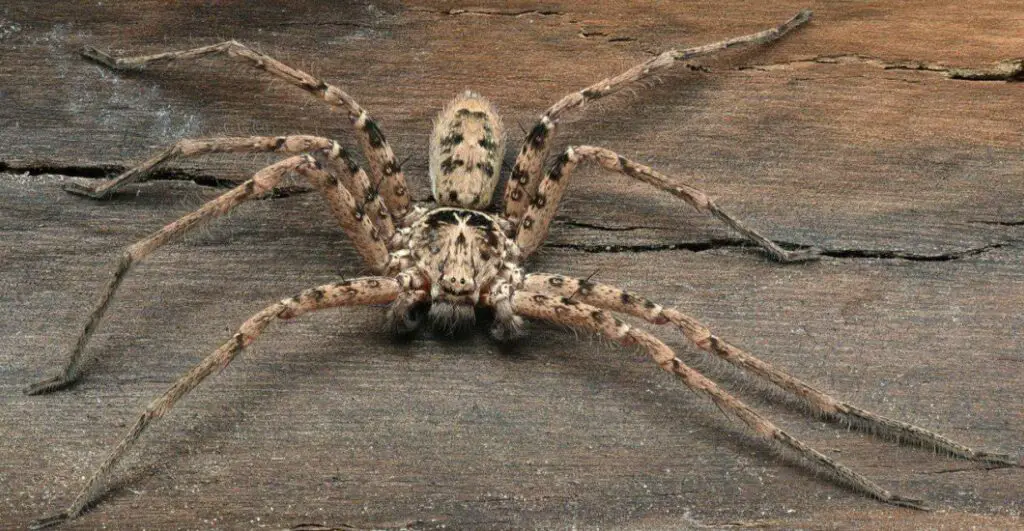
Discovered as recently as 2001 by German arachnologist Peter Jäger, this species remained hidden from science for millennia in the remote cave systems of Southeast Asia.
World Wide Fund for Nature representatives expressed amazement that such a massive creature could escape scientific detection for so long, with one spokesman noting that “some of these species really have no business being recently discovered.”
The giant huntsman weighs approximately 167 grams, making it slightly lighter than its South American rival but compensating with significantly longer legs.
Its pale coloration and specialized leg hairs indicate millions of years of cave adaptation, while its crab-like leg positioning allows it to navigate cave walls with remarkable agility.
Unlike web-building spiders, huntsman spiders are active hunters that can move up to 3 feet per second when pursuing prey.
02. Goliath Birdeater (Theraphosa blondi)
While the giant huntsman claims the crown for leg span, South America’s Theraphosa blondi dominates the weight category.
The goliath birdeater, despite its intimidating name, rarely actually consumes birds, instead preferring a diet of insects, small mammals, and amphibians.

This massive tarantula can reach a leg span of up to 12 inches and weigh an incredible 175 grams, equivalent to the weight of six house sparrows.
Individual specimens have reached even more impressive dimensions, with one captive female named Rosi weighing 170 grams with a body length of 4.7 inches, not including her legs.
The species inhabits the rainforests of northern South America, particularly in Venezuela, Brazil, Guyana, and French Guiana.
Females can live 15 to 25 years, while males typically survive only three to six years.
Their impressive fangs measure 2 to 4 centimeters in length, capable of penetrating human skin, though their venom poses minimal threat to humans.
03. Brazilian Salmon Pink Birdeater (Lasiodora parahybana)
Brazil hosts several species that rank among the world’s largest spiders.
The Brazilian salmon pink birdeater (Lasiodora parahybana) stands as the third-largest spider globally, with females reaching 25 to 28 centimeters in leg span and weighing over 100 grams.

This species demonstrates remarkable growth rates, with some specimens reaching adult size within two years.
The distinctive salmon-colored setae on their legs and abdomen give them their common name, though despite being called “birdeaters,” they primarily consume insects and occasionally small vertebrates.
The species exhibits sexual dimorphism, with females significantly outgrowing males and living substantially longer.
Females can reach 10 inches in leg span, while males typically max out around 6 inches.
This tarantula has become increasingly popular in the pet trade due to its impressive size and relatively docile temperament.
04. Brazilian Giant Tawny Red Tarantula (Grammostola anthracina)
The Brazilian giant tawny red tarantula (Grammostola anthracina) rounds out the South American giants with a leg span reaching 10 inches.
This species exhibits two distinct color morphs, with some individuals displaying jet-black coloration while others show the characteristic reddish-brown hues that give the species its common name.
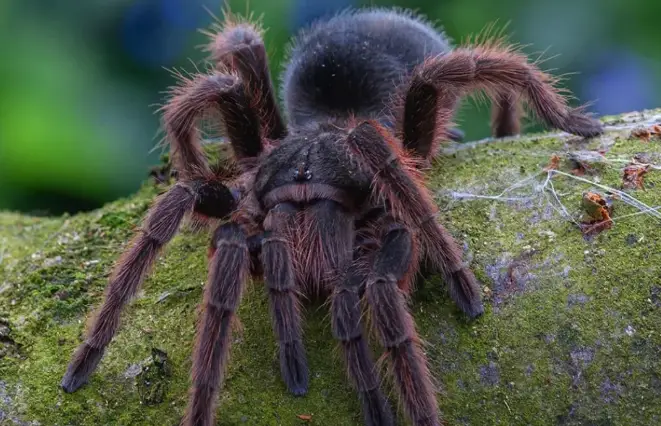
This species demonstrates remarkable longevity, with females capable of living over 20 years in captivity.
The species constructs elaborate burrow systems and exhibits fossorial behavior, spending most of its time underground.
Adult females can weigh up to 90 grams, making them substantial even among the world’s largest spiders.
The Brazilian giant tawny red inhabits the grasslands and scrublands of South America, where it plays a crucial role as an apex predator of the invertebrate community.
Its powerful build and impressive fangs make it capable of subduing prey as large as small rodents and lizards.
05. Face-Size Tarantula (Poecilotheria rajaei)
Sri Lanka’s scientific community made headlines in 2013 with the discovery of Poecilotheria rajaei, aptly nicknamed the “face-sized tarantula.”
This arboreal species boasts leg spans of 8 inches (20 centimeters), genuinely matching the size of a human face.
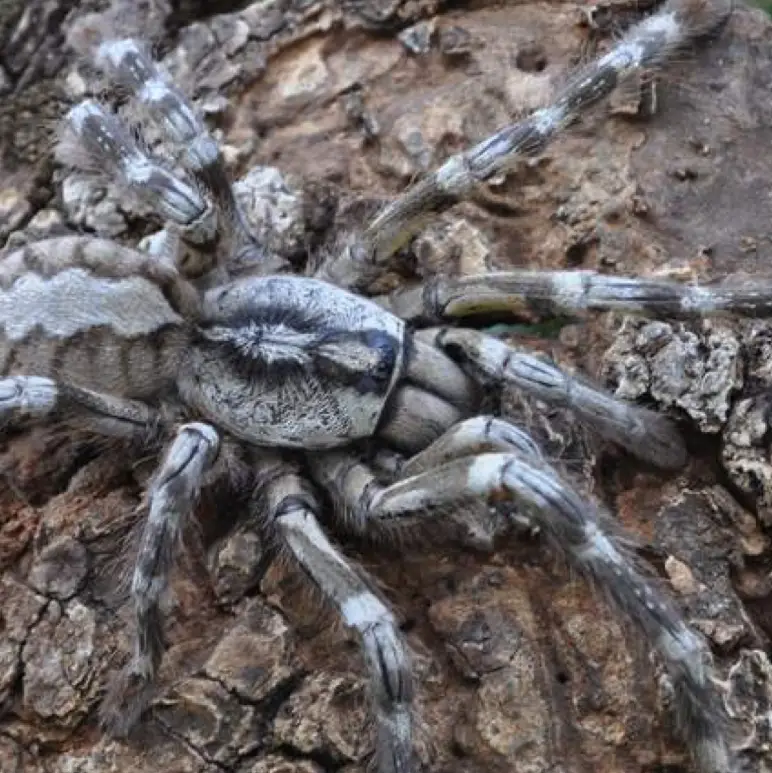
The species features distinctive daffodil-yellow markings on its first and fourth legs combined with a characteristic pink abdominal band.
Named after police inspector Michael Rajakumar Purajah, who guided researchers through post-civil war areas to locate the spider, this species represents the ongoing discovery of massive arachnids in remote regions.
Unfortunately, deforestation threatens the species’ survival, as these spiders prefer well-established old trees but increasingly seek shelter in abandoned buildings due to habitat loss.
The species was officially described in a 2012 publication after being discovered in 2009 when a villager brought a dead specimen to researchers.
06. Hercules Baboon Spider (Hysterocrates hercules)
West Africa contributes its own giant to the global roster with Hysterocrates hercules, the Hercules baboon spider.
This fossorial species can achieve leg spans of up to 7.9 inches and represents one of the largest African tarantula species.
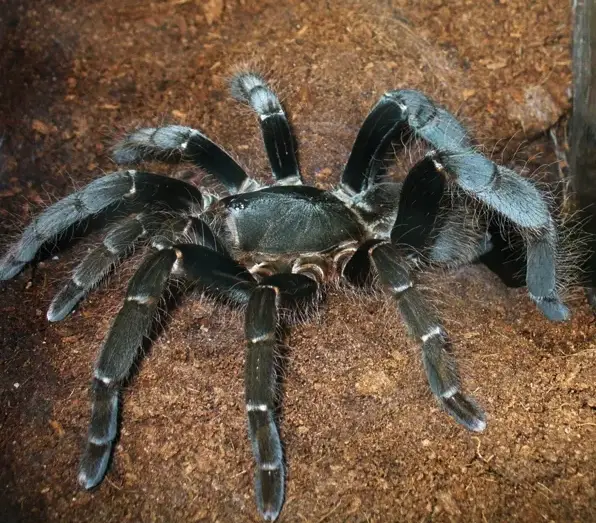
The Hercules baboon spider exhibits unique defensive behaviors and constructs elaborate underground burrows.
These spiders can live over 15 years in captivity and are known for their robust build and powerful fangs.
Their copper-to-brown coloration deepens with age, and their impressive size reflects their position as apex predators in West African scrublands.
The species may be critically endangered, with the only known specimen stored in London’s Natural History Museum having been found more than a century ago.
Recent expeditions to locate living specimens have been largely unsuccessful, raising concerns about the species’ current status.
07. Colombian Giant Redleg Tarantula (Megaphobema robustum)
Colombia’s rainforests harbor Megaphobema robustum, the Colombian giant redleg tarantula, which reaches impressive 6 to 8-inch leg spans.
This species exhibits striking coloration with bright orange-red legs contrasting against a deep black carapace.
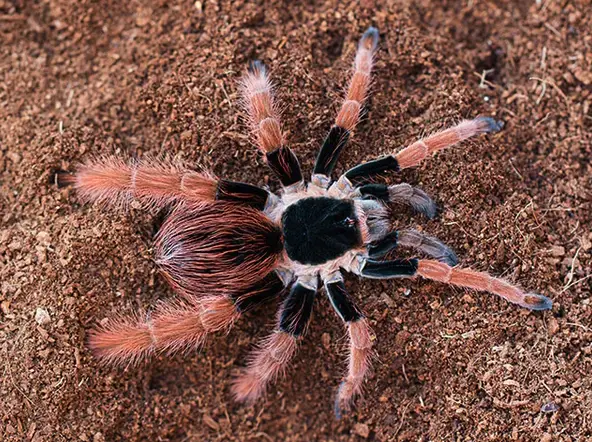
The Colombian giant redleg demonstrates impressive growth rates and can reach adult size within 3-4 years.
Females can weigh up to 85 grams and live over 15 years, while males typically survive only 3-4 years.
The species constructs burrows in the forest floor and exhibits both fossorial and semi-arboreal behaviors.
This tarantula has become increasingly sought after in the exotic pet trade due to its impressive size and striking coloration.
However, habitat destruction in Colombian rainforests poses ongoing threats to wild populations.
08. Indian Ornamental Tree Spider (Poecilotheria regalis)
India contributes the Poecilotheria regalis, the Indian ornamental tree spider, with leg spans sometimes exceeding 7 inches (18 centimeters).
This arboreal species displays intricate fractal-like patterns on its abdomen and represents one of the most sought-after species among tarantula enthusiasts.
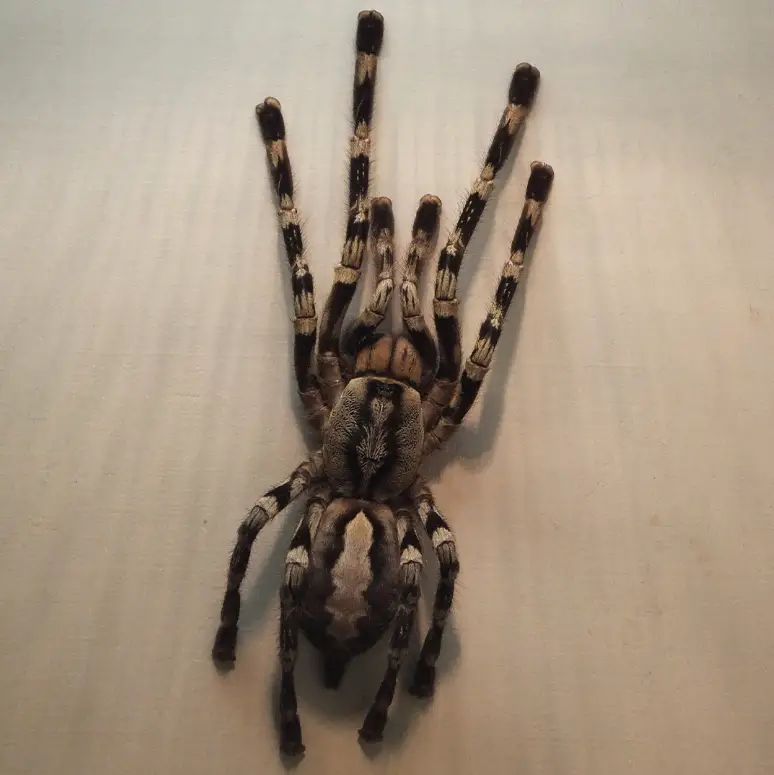
The Indian ornamental exhibits remarkable speed and agility, capable of moving at lightning-fast speeds when threatened.
The species displays complex coloration patterns with gray and white banding on the legs and distinctive geometric patterns on the abdomen that resemble traditional Indian artwork.
Females can live over 12 years, while males typically survive only 2-3 years after reaching maturity.
The species constructs elaborate silk retreats in tree hollows and demonstrates sophisticated hunting behaviors, often waiting motionless for hours before striking at prey.
09. Brazilian Wandering Spider (Phoneutria fera)
Brazil’s Phoneutria species, commonly known as Brazilian wandering spiders, combine impressive size with potent venom.
These active hunters can achieve leg spans of 13 to 18 centimeters and body lengths reaching 48 millimeters.

Unlike the predominantly sedentary tarantulas on this list, Brazilian wandering spiders are highly active nocturnal hunters that roam forest floors in search of prey.
They exhibit aggressive defensive postures when threatened, rearing up on their hind legs and displaying their fangs.
The species possesses medically significant venom that can cause serious symptoms in humans, including intense pain, muscle cramps, and in rare cases, more severe systemic effects.
However, fatalities are extremely rare due to the availability of effective antivenoms.
10. Cerbalus aravaensis
The Middle East’s contribution comes from Israel and Jordan’s Cerbalus aravaensis, with a leg span of 14 centimeters (5.5 inches).
This huntsman spider represents the largest arachnid in the Middle East and constructs ingenious underground dens with hinged, camouflaged entrances.
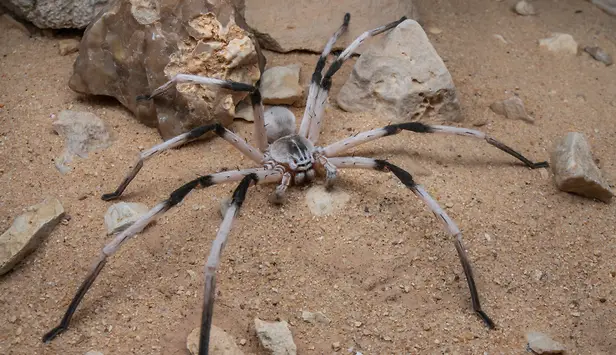
Discovered in 2007, this species inhabits the sand dunes of the Arava Desert, where it has evolved specialized adaptations for desert survival.
The spider creates elaborate burrow systems with trap-door entrances covered by sand and held together with silk.
The species faces significant conservation challenges as its sand dune habitat shrinks from agricultural development and mining operations.
Climate change and human encroachment continue to threaten the limited remaining habitat of this remarkable desert specialist.
| Rank | Spider Species | Leg Span | Weight | Location |
|---|---|---|---|---|
| 1 | Giant Huntsman Spider | 12.0 inches | 167g | Laos |
| 2 | Goliath Birdeater | 11.0 inches | 175g | South America |
| 3 | Brazilian Salmon Pink Birdeater | 10.5 inches | 100g+ | Brazil |
| 4 | Brazilian Giant Tawny Red Tarantula | 10.0 inches | N/A | South America |
| 5 | Face-Size Tarantula | 8.0 inches | N/A | Sri Lanka |
| 6 | Hercules Baboon Spider | 7.9 inches | N/A | West Africa |
| 7 | Colombian Giant Redleg Tarantula | 7.0 inches | N/A | Colombia |
| 8 | Indian Ornamental Tree Spider | 7.0 inches | N/A | India |
| 9 | Brazilian Wandering Spider | 5.9 inches | N/A | South America |
| 10 | Cerbalus aravaensis | 5.5 inches | N/A | Israel/Jordan |
Side Note: The Megarachne – A Giant Arachnid from the Ancient Past
One of the most intriguing contenders for the title of the largest spider in history is Megarachne, an ancient arthropod whose fossilized remains were discovered in the Bajo de Véliz Formation of San Luis, Argentina.
Living around 300 million years ago during the Carboniferous period, Megarachne was originally heralded as the largest spider ever to have existed, with body estimates reaching up to 34 centimeters and a supposed leg span of 50 centimeters—far outsizing today’s giants like the goliath birdeater and the giant huntsman spider.
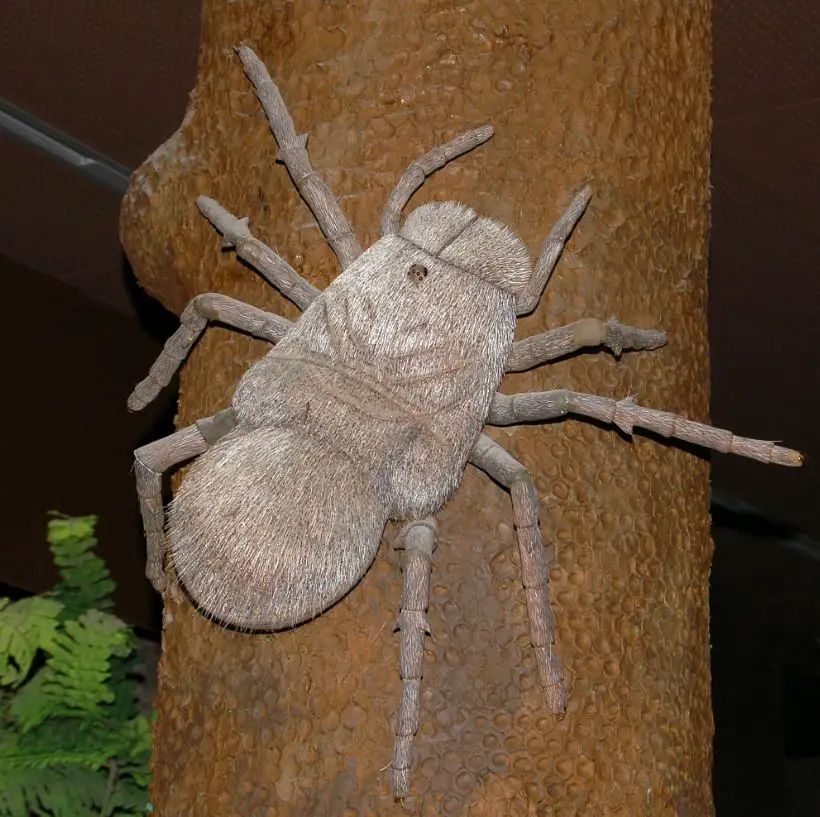
However, later scientific scrutiny determined that Megarachne was not a true spider, but rather a eurypterid—a group of freshwater “sea scorpions” closely related to modern arachnids.
Despite this reclassification, its story continues to fascinate both paleontologists and enthusiasts, as it holds the record for being the most complete eurypterid specimen ever found in Carboniferous deposits of South America.
While Megarachne may have been dethroned in the race for the largest spider, its impressive size and dramatic scientific history remind us how much there still is to learn about both ancient giants and the modern-day rulers of the arachnid world.
Discovery Frontiers
The discovery rate of giant spider species continues accelerating, with over 1,000 new plant and animal species found between 1997 and 2007 in the Greater Mekong region alone.
However, habitat destruction threatens many species before scientists can properly study them.
Research into these massive arachnids extends beyond mere size documentation.
Scientists study their venom for potential medical applications, with king baboon spider venom being investigated for chronic pain treatments.
The defensive mechanisms, hunting strategies, and ecological roles of these giants continue revealing new insights into arachnid evolution and behavior.
Modern molecular techniques promise to refine our understanding of spider relationships and may reveal additional cryptic species hiding within current classifications.
The combination of traditional field work and cutting-edge genetic analysis suggests that Earth’s catalog of giant spiders remains far from complete, with remote rainforests, deep caves, and unexplored habitats likely harboring additional colossal discoveries waiting for scientific documentation.
Watch: 10 Largest Spiders Ever Encountered!
These remarkable arachnids represent millions of years of evolutionary adaptation, each species perfectly suited to its unique ecological niche.
From the cave-dwelling giant huntsman with its extraordinary leg span to the powerful goliath birdeater with its impressive mass, these spiders demonstrate the incredible diversity and specialization possible within the arachnid world.
Their continued study promises to unlock new secrets about evolution, behavior, and the intricate relationships that govern our planet’s ecosystems, while their conservation remains crucial for maintaining biodiversity in an increasingly threatened natural world.



































